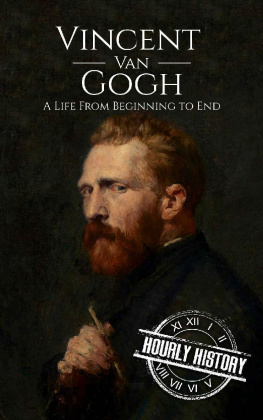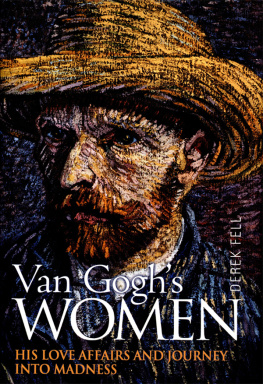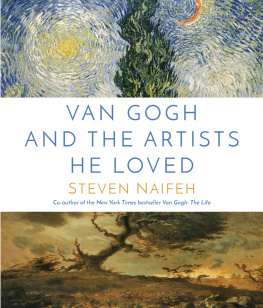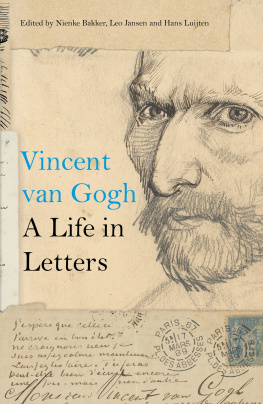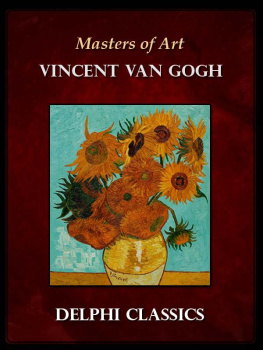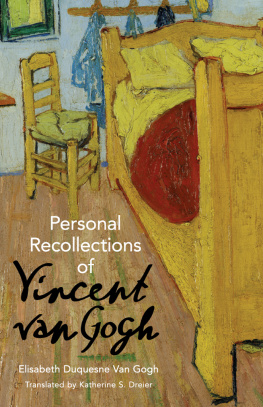Ever Yours

Vincent van Gogh
Ever YoursThe Essential Letters
Edited by Leo Jansen, Hans Luijten, and Nienke Bakker

This publication is part of the Van Gogh Letters Project executed under the auspices of the Van Gogh Museum, Amsterdam, and Huygens ING (a division of the Royal Netherlands Academy of Arts and Sciences), The Hague, and is an abridged edition of the complete six-volume publication, Vincent van GoghThe Letters: The Complete Illustrated and Annotated Edition, edited by Leo Jansen, Hans Luijten, and Nienke Bakker (Brussels: Mercatorfonds; London and New York: Thames and Hudson, 2009).
www.vangoghletters.org

www.vangoghmuseum.com

www.huygens.knaw.nl
Copyright 2014 Van Gogh Museum, Amsterdam.
All rights reserved. This book may not be reproduced, in whole or in part, including illustrations, in any form (beyond that copying permitted by Sections 107 and 108 of the U.S. Copyright Law and except by reviewers for the public press), without written permission from the publishers.
Published in 2014 by Yale University Press,
New Haven and London

yalebooks.com/art
The publisher gratefully acknowledges the support of the Dutch Foundation for Literature.

Translation of introduction texts: Diane Webb
Translation of the Van Gogh letters:
Translation editor: Michael Hoyle
Translations from the Dutch by Lynne Richards,
John Rudge and Diane Webb
Translations from the French by Sue Dyson
and Imogen Forster
Library of Congress Control Number:
2014939683
ISBN 978-0-300-20947-1
e-book ISBN 978-0-300-21148-1
A catalogue record for this book is available from the British Library.
Jacket illustrations: (front) detail of letter 400,
1883; (back) detail of letter 609, 1888
Frontispiece: detail of letter 660, 1888
All of the letters in this volume belong to the Vincent van Gogh Foundation and are in the Van Gogh Museum, with the exception of the following letters and pages from letters: Fonds Van der Linden, Muses Royaux des Beaux-Arts de Belgique, Brussels: 821; Institut National dHistoire de lArt, Paris: 695; Muse Rettu, Arles: 739; private collections: 325, 569, 665, 691 (part), 740, 756, 853; Thannhauser Collection, Guggenheim Museum, New York: 849; Thaw Collection, The Morgan Library & Museum, New York: 587, 599, 622, 628, 632, 651, 655, 698, 706, 822; and present whereabouts unknown: 716, 776 (part)
Contents
Leo Jansen, Hans Luijten, and Nienke Bakker
Setbacks and Perseverance:An Artists Life
Leo Jansen, Hans Luijten, and Nienke Bakker
Sorrowful, yet alway rejoicing.
2 Corinthians 6:10
The letters and artworks of Vincent van Gogh (18531890) strike at the very heart of desires and emotions we all share. Intensely inquisitive, Van Gogh absorbed the world around him, but the only way he could relate to that world was to create a counterworld in words and images. He wanted to make art that would comfort people: a consolatory art for distressed hearts (letter 739), by means of compelling colours and peerless lines. His letters are a masterly account of how he set out to achieve this and what drove him to persevere in this endeavour.
Van Gogh was enthusiastic to the point of fanaticism; he set excruciatingly high hurdles for himself, and struggled long and hard to overcome them. His personal life became completely subordinate to art, as time and again he gave his utmost to further his cause, thinking it only natural that he should do so. That this attitude had its dangers had already dawned on him five years before his death: The fact that I have a definite belief as regards art also means that I know what I want to get in my own work, and that Ill try to get it even if I go under in the attempt (531).
Vincent van Gogh was a jack-of-all-trades and master of none until 1880, when he decided to pursue an artistic career and gradually came to grips with his destiny. With hindsight it can be said that he developed as an artist with amazing speed: it took him only ten years to draw and paint the extensive oeuvre that would make him world-famous. Recognition was a long time in coming, however. Only after his self-inflicted death in 1890 did his work finally begin to receive the attention it deserved and his reputation as a pioneering artist become firmly establisheda development in which his letters played a vital role.
Vincent van Gogh: A Complex Character
Van Gogh cut a striking figure. Jo van Gogh-Bonger, who became acquainted with Vincent in 1890, described him in her introduction to the 1914 letters edition as a robust, broad-shouldered man with a healthy complexion, a cheerful expression and something very determined in his appearance. Small in stature, he had green eyes, a red beard and freckles; his hair was ginger-coloured like that of his brother Theo, his junior by four years. He had a facial tic, and his hands seemed to be in constant motion. He was rather unsociable, which made him difficult to live with. People were often afraid of him, because of his wild and unkempt appearance and his intense manner of speaking. The way he looked and acted alienated people, which did not make life easy for him.
Van Gogh was almost always convinced that he was right, and this made him quite tiresome. He was a passionate, driven man, whose tendency to act like an egocentric bully made many people dislike him. They saw him as a madmana murderera vagabond (408). Van Gogh refused to let this upset him: [B]elieve me that I sometimes laugh heartily at how people suspect me (who am really just a friend of nature, of study, of workand of people chiefly) of various acts of malice and absurdities which I never dream of (252). He did not avoid confrontations, nor did he spare himself. Theo described him in a letter of March 1887 to their sister Willemien as his own enemy.
Van Gogh was strongly inclined towards introspection: he never hesitated to explore and record his mood swings, or to redefine his moral position. He did this mainly because he had few people to talk to. Examining his own state of mind, he saw a highly strung individual. At the age of twenty-nine, he sketched a merciless picture of himself:
Dont imagine that I think myself perfector that I believe it isnt my fault that many people find me a disagreeable character. Im often terribly and cantankerously melancholic, irritableyearning for sympathy as if with a kind of hunger and thirstI become indifferent, sharp, and sometimes even pour oil on the flames if I dont get sympathy. I dont enjoy company, and dealing with people, talking to them, is often painful and difficult for me. But do you know where a great deal if not all of this comes from? Simply from nervousnessI who am terribly sensitive, both physically and morally, only really acquired it in the years when I was deeply miserable. (244)
Next page

